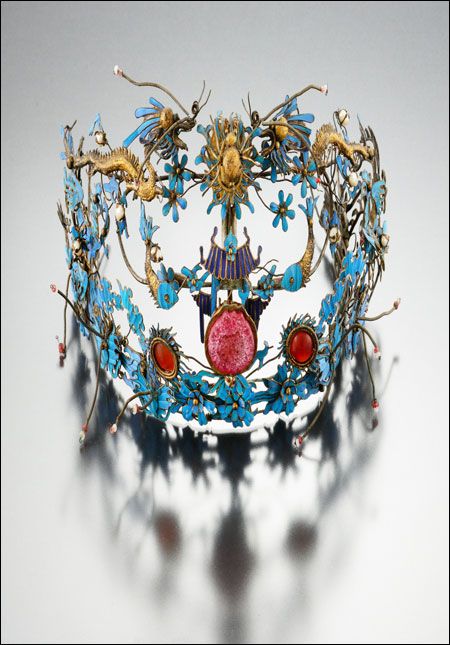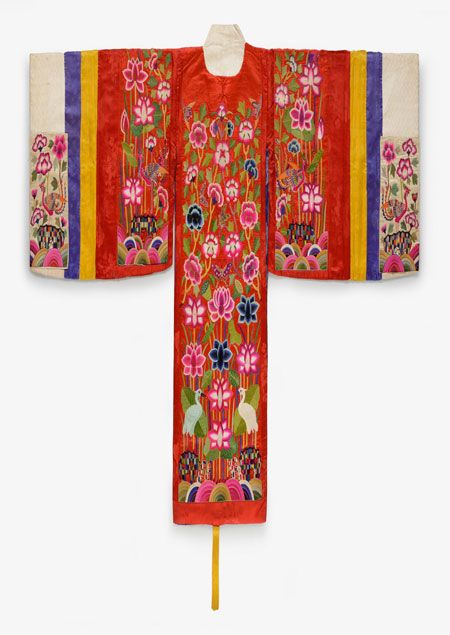
Similar but unique wedding rituals of 5 countries

Modern weddings in Korea are quick and simple: a speedy ceremony and then rushing to the meal afterwards. But in the past weddings were days-long festivals among families and friends that embraced cultural elements.
The diversity and uniqueness of wedding rituals from Korea, China, Japan, Nepal and Vietnam can be seen at a special exhibition at the National Folk Museum of Korea through Feb. 11.
The museum has studied various wedding rituals of 25 tribes in five countries for five years including field investigations and interviews. A total of 863 items from the Beijing Folk Arts Museum and the National Museum of Japanese History and individuals from the different nations are on display.
“While doing the research, we found similarities among the five countries in traditional wedding rituals,” exhibition curator Choi Eun-soo said.
Technology including transparent display methods and miracle glass is used to effectively show the documents and photos.
In the exhibition hall, four video screens showing flamboyant wedding outfits from the five countries capture the attention of visitors.

The first part of the exhibition includes invitations, engagement and wedding gifts and books and documents usually exchanged before the wedding. The curator said that the five countries share cultural practices such as exchanging letters containing the birth dates of the bride and groom to check their marital compatibility with a fortune teller.
Gifts were exchanged before the wedding ceremony although they vary by nation. In Nepal, household goods such as bowls and dishes are popular wedding presents. In China, the bride’s family gives stationery such as brushes to the groom while a groom’s family offers jewelry set to the bride.
The traditional Vietnamese wedding ceremony can’t start without a gift of “Trau Cau” which symbolizes love and loyalty. Trau Cau is ground areca nut, which is synonymous with marriage. Chewing it with lime paste is a custom in daily life, which turns teeth black. The traditional Japanese wedding ceremony also begins with the presentation of a gift box which carries letters along with some money for buying an obi belt, regarded as a luxurious, expensive item for kimono. “It’s very similar to the Korean wedding culture,” the curator said.
The second section shows wedding items such as paintings, decorations and utensils used for the ceremony. Ornaments such as a wild goose figurine in Korea, a pheasant and a snapper in Japan, Trau Cau in Vietnam, a spirit tablet in China and a leaf-shaped silver statue in Nepal are used to signify the harmony and loyalty of the couple.
The third section features bridal chambers using high technology. Transparent glass creates moving images of a bride and a groom entering the chamber after a wedding ceremony in the Japanese bridal room. After the images fade, the actual room appears behind the screen.
“Most of the countries we researched have not preserved traditional wedding rituals very well. Modern ceremonies are more prevalent. Koreans hold their traditional wedding ceremonies in Korean House and other places although the format is simplified,” Choi said. One traditional element, “pyebaek” or the couple’s greeting of the groom’s family, still remains in the modern Korean wedding ceremony.
The last exhibit highlights various modern and traditional wedding garments from the five countries. A variety of wedding dresses includes those designed by the late iconic designer Andre Kim. There are also models wearing “hanbok” (traditional Korean costumes) from wedding ceremonies in the 1940s in Pyongyang, North Korea. “In the 1940s, North Koreans put more emphasis on hair accessories,” the curator said. In Japan, the robes are marked with a family symbol.
The highlight of the exhibition is a multimedia table which shows various images of newlyweds and related stories attached to photos. Tapping on the photo, the related stories pop up on a wide screen. The table can be used by six people at the same time. The technique was developed by KAIST professor Kim Jung-hwa. The content includes 700 photos of 97 couples who married between 1933 and 2012 along with their stories.
Admission is free. For more information, call (02) 3704-3114 or visit www.nfm.go.kr. <The Korea Times/Chung Ah-young>


